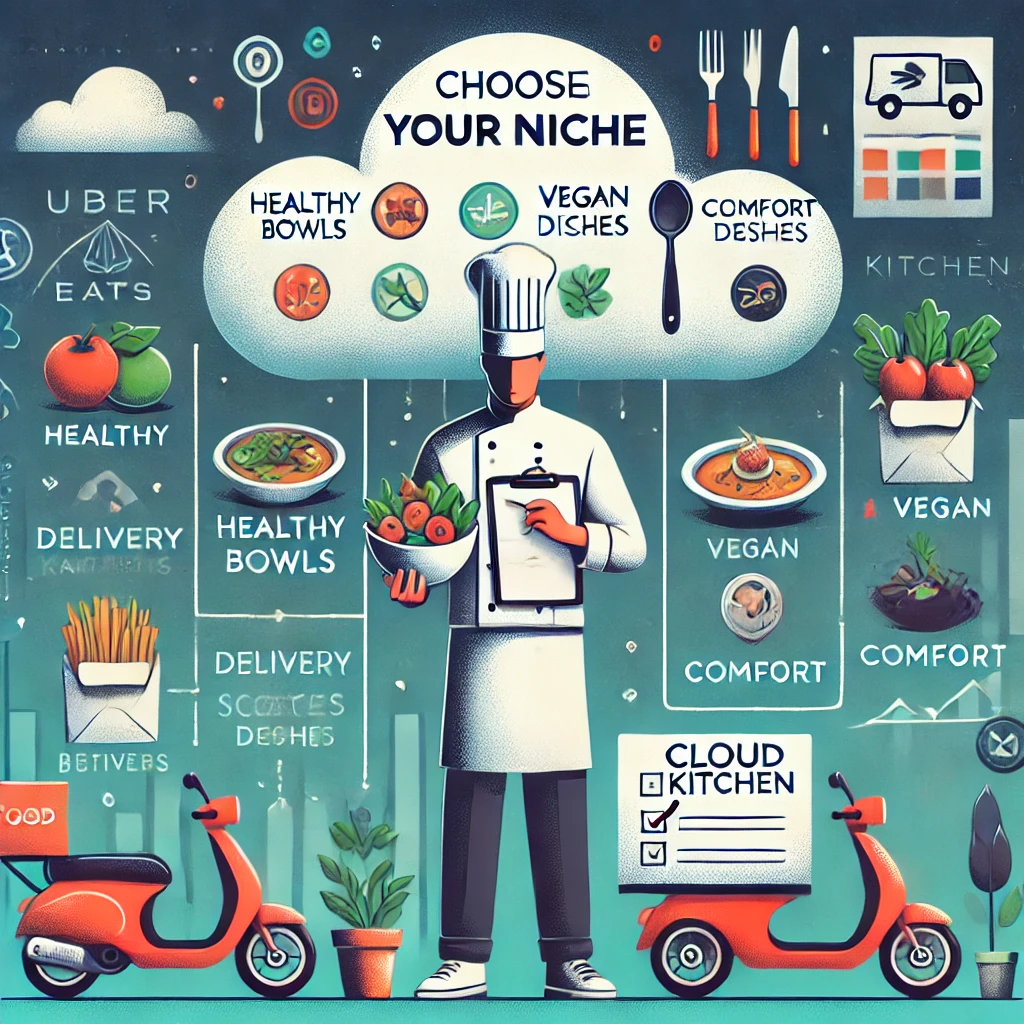Table of Contents
ToggleIntroduction
Choosing the right niche is a critical step in launching a cloud kitchen. A well-defined niche allows you to stand out in a competitive market, target a specific audience, and streamline operations. In this guide, we’ll explore how to select the perfect niche for your cloud kitchen by evaluating trends, market demand, and profitability.
1. What is a Cloud Kitchen Niche, and Why Does it Matter?
A cloud kitchen niche focuses on a specific type of food or catering to a particular dietary need, such as healthy bowls, plant-based dishes, or comfort foods. Having a clear niche helps you:
- Stand out from competitors in a crowded food delivery space.
- Align your menu with customer preferences, increasing satisfaction.
- Simplify operations by focusing on core dishes and minimizing waste.
- Build brand loyalty with targeted offerings that keep customers coming back.
Selecting a niche ensures that your business is focused and has a higher chance of achieving sustainable growth.
2. Types of Popular Cloud Kitchen Niches
Choosing a niche depends on market demand, your interests, and profitability. Below are some of the most popular and profitable niches:
- Healthy Meal Bowls: Cater to health-conscious consumers with ingredients like quinoa, kale, and lean proteins.
- Vegan and Plant-Based: Tap into the growing demand for plant-based diets with vegan burgers, bowls, and desserts.
- Comfort Foods: Offer burgers, pasta, or fried chicken—always in demand, especially for late-night orders.
- Ethnic Cuisines: Specialize in a cuisine such as Mexican, Thai, or Indian, which appeals to diverse audiences.
- Dessert-Only Kitchens: Focus on sweet treats like cakes, cookies, and artisanal ice cream.
- Meal Prep and Subscription Plans: Provide pre-portioned meals that customers can order weekly for convenience.
3. How to Analyze Market Demand for Your Niche
Conducting market research helps you identify what customers are looking for and where your kitchen can fit in.
Steps to Analyze Market Demand:
- Use Google Trends: Check if specific cuisines or food types are gaining popularity in your area.
- Research on Delivery Platforms: Look at which food categories are trending on Uber Eats or Foodpanda.
- Competitor Research: Study the menus and customer reviews of cloud kitchens offering similar items.
- Customer Surveys: Ask your target audience directly what types of meals they prefer or feel are missing from the market.
4. Matching Your Niche with Your Target Audience
Aligning your menu with your target audience ensures higher engagement and loyalty.
Steps to Align with Customer Preferences:
- Consider Demographics: Are you targeting college students, office workers, or families? Each group has different preferences.
- Match Local Preferences: In some regions, offering Halal, gluten-free, or vegan options may attract more customers.
- Time-Sensitive Audiences: If your niche involves quick meals or office lunches, ensure that you can deliver efficiently during peak hours.
- Seasonal Menus: Offer seasonal items or festive menus to appeal to customers during holidays or special events.
5. Evaluating the Profitability of Your Niche
Assessing the profitability of your niche ensures that your kitchen will remain sustainable over time.
How to Assess Profitability:
- Calculate Food Costs and Markup: Focus on high-margin items with affordable ingredients.
- Estimate Operational Expenses: Include rent, staff salaries, utilities, and packaging costs.
- Forecast Order Volume: Use competitor data to predict how many daily orders you can expect.
- Account for Seasonal Demand: Identify which months might see higher or lower sales (e.g., comfort foods in winter).
6. Assessing Operational Feasibility
Your chosen niche should be easy to manage in terms of ingredients, delivery, and equipment.
Key Considerations:
- Ingredient Availability: Make sure that essential ingredients are available locally and consistently.
- Delivery Feasibility: Foods like soups or ice cream may require special packaging to ensure quality during delivery.
- Special Equipment: Some cuisines might need specific tools, such as pizza ovens or high-speed blenders.
- Packaging Solutions: Choose containers that keep the food fresh and maintain its presentation.
7. Trends and Future-Proofing Your Niche
Keeping an eye on emerging trends will ensure your cloud kitchen remains relevant and sustainable.
Trends to Watch:
- Plant-Based and Organic Foods: The demand for sustainable and health-focused food options is on the rise.
- Eco-Friendly Packaging: Customers are increasingly preferring restaurants that use biodegradable packaging.
- Subscription-Based Models: Offering meal subscriptions ensures recurring revenue and customer loyalty.
- Virtual Brands: Create multiple brands under one kitchen to cater to different niches without increasing costs.
8. Case Study: Successful Cloud Kitchen Niche Ideas
Learning from real-world examples can inspire your kitchen concept.
Successful Niche Examples:
- Vegan Comfort Foods: A cloud kitchen offering vegan comfort dishes like mac & cheese and brownies achieved a 50% growth within six months by tapping into local vegan communities.
- Smoothie Bowls and Health Snacks: A kitchen targeting fitness enthusiasts partnered with local gyms, resulting in consistent repeat orders.
- Regional Cuisines for Festivals: A kitchen specializing in regional delicacies boosted visibility by offering seasonal menus during festivals and holidays.
9. Testing Your Niche with a Soft Launch
Before committing fully, consider a soft launch to test your concept.
Steps for a Successful Soft Launch:
- Offer a Limited Menu: Start with a small selection to gather customer feedback.
- Collaborate with Influencers: Engage with local food influencers to promote your soft launch.
- Track Customer Feedback: Use reviews and surveys to improve your offerings.
- Evaluate Operations: Check if your kitchen workflow can handle peak orders efficiently.
Conclusion
Choosing the right niche for your cloud kitchen sets the foundation for a successful business. By focusing on market trends, customer needs, and profitability, you can develop a concept that stands out and thrives in a competitive food delivery market. Keep refining your offerings, test new ideas with soft launches, and stay updated on trends to ensure long-term growth.



